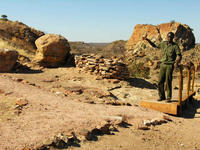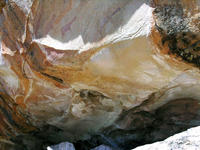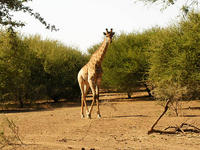You are in: Africa -> South Africa -> Mapungubwe Cultural ... , and traditional search or Image Gallery will yield results of this site only
Mapungubwe Cultural Landscape
| Site number: | 1099 |
|
| Type of site: | Cultural | |
| Date: | 14th century | |
| Date of Inscription: | 2003 | |
| Location: | Africa, South Africa, Northern Province | |
Up to 75 images are shown here. Click on each for more details or on Image Gallery for more images.
| Description: | Mapungubwe is an open, expansive savannah landscape that sits right beside South Africa’s northern border, joining together Zimbabwe and Botswana at the confluence of the Limpopo and Shashe rivers. Before being abandoned in the 14th century, Mapungubwe developed into the largest kingdom within the sub-continent. Presenting an unrivalled depiction of the social and political structural development of some 400 years are the various elements that still remain intact: two earlier capital sites, the almost untouched remains of the palace sites as well as the entire settlement area dependent upon them. --WHMNet paraphrase from the description at WHC Site, where additional information is available. | |
| Mapungubwe was a city in what is now northern South Africa. Flourishing from AD 1050 to AD 1270 at the confluence of the Shashe and Limpopo rivers (22°2′S, 29°36′E), it marked the center of a pre-Shona kingdom which covered parts of modern-day Botswana and Zimbabwe. The site of the city is now a World Heritage site, national park, and archaeological site. The Mapungubwe Landscape was declared a World Heritage Site on 3 July 2003. Mapungubwe Hill means “place of jackals”. It is a sandstone hill, with vertical cliffs about 30 metres high and a plateaued top approximately 300 m in length. The hill was inhabited for about seventy years between AD 1220 and AD 1290. Mapungubwean society was "the most complex in southern Africa". It is thought by archaeologists to be the first class-based social system in southern Africa; that is, its leaders were separated from and higher in rank than its inhabitants. Life in Mapungubwe was centered around family and farming. Special sites were created for initiation ceremonies, household activities, and other social functions. Cattle lived in kraals located close to the residents' houses, signifying their value. Most speculation about society continues to be based upon the remains of buildings, since the Mapungubweans left no written or oral record. After Mapungubwe's fall, it was forgotten until 1932. On New Year’s Eve 1932, E. S. J. van Graan, a local farmer and prospector, and his son, a former student of the University of Pretoria, discovered the wealth of artifacts on top of the hill. They reported the find to Professor Leo Fouché of the University of Pretoria, paving the way for excavations that continue to this day. As many gold artifacts were found, Mapungubwe's location was initially kept secret for fear of looting. The artifacts found dated from approximately 1000 AD to 1300 AD and consisted of a variety of materials such as pottery, trade glass beads, Chinese celadon ware, gold ornaments (including the famous golden rhino), ceramic figurines, organic remains, crafted ivory and bone and refined copper and iron. The area is now part of Mapungubwe National Park, which with the Tuli Block (Botswana) and the Tuli Safari area (Zimbabwe), forms part of Limpopo/Shashe Transfrontier Park. --Wikipedia. Text is available under the Creative Commons Attribution-ShareAlike License. | ||
| Source: | http://whc.unesco.org/en/list/1099 | |
| Reference: | 1. UNESCO World Heritage Center, Site Page. | |



















